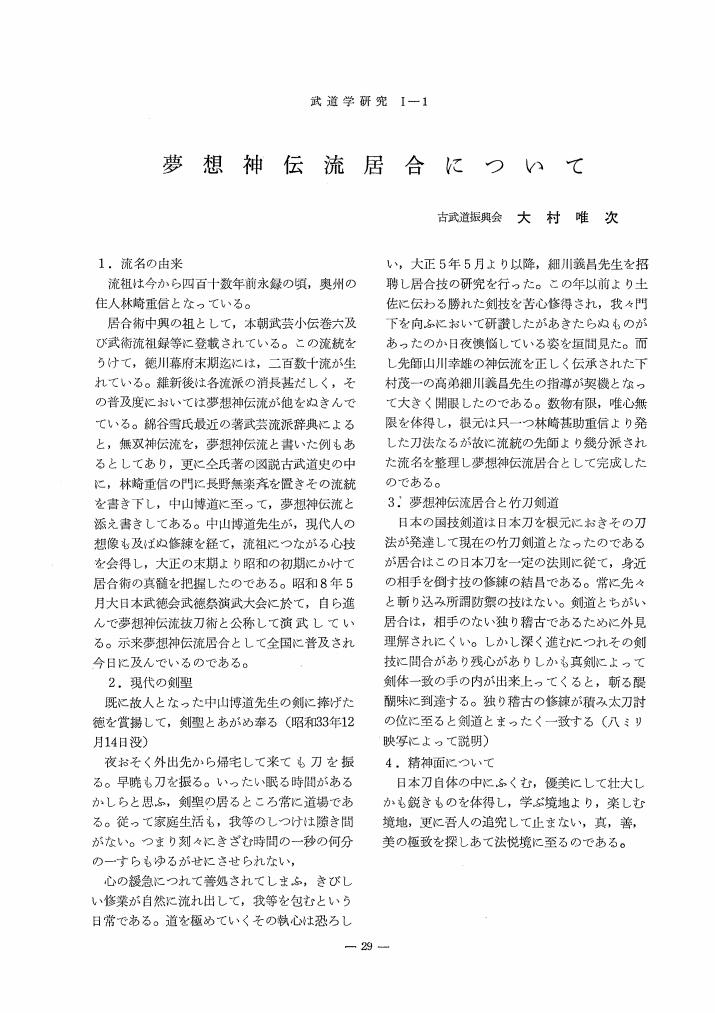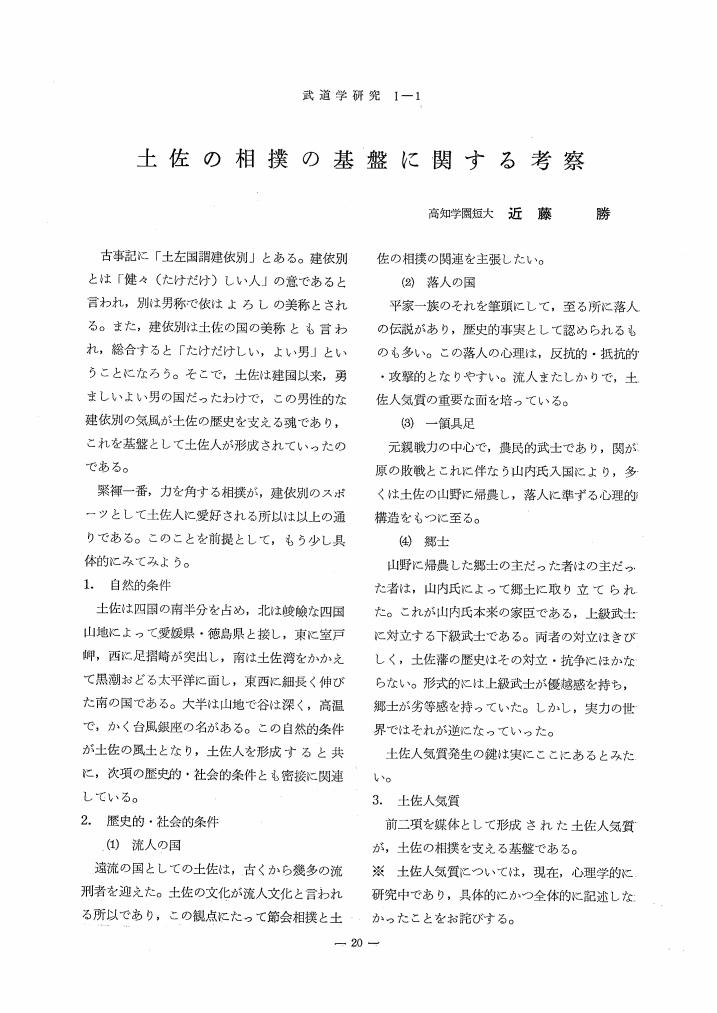1 0 0 0 OA 肥後熊本藩の宝蔵院流
- 著者
- 石川 哲也
- 出版者
- 日本武道学会
- 雑誌
- 武道学研究 (ISSN:02879700)
- 巻号頁・発行日
- vol.39, no.Supplement, pp.10, 2006 (Released:2012-11-27)
1 0 0 0 OA 国際柔道連盟試合審判規程における従来の審判員配置が投技評価数と異見発生数に及ぼす影響
- 著者
- 林 弘典 石川 美久 生田 秀和
- 出版者
- 日本武道学会
- 雑誌
- 武道学研究 (ISSN:02879700)
- 巻号頁・発行日
- vol.56, no.1, pp.29-39, 2023 (Released:2023-11-14)
- 参考文献数
- 34
This study aimed to clarify the number of nage-waza (throwing techniques) acknowledgements and objections from inside and outside the triangle made by the referees in the conventional referee positions using the International Judo Federation Refereeing Rules. The findings of the study are as follows.1. Nage-waza acknowledgements were performed 200 times (47.4%) inside the triangle connecting the three referees with a straight line and 222 times (52.6%) outside the triangle, with no significant differences.2. No objections (3-0) were made 168 times (47.6%) inside the triangle connecting the three referees with a straight line and 185 times (52.4%) outside the triangle, with no significant differences.3. Objections (2-1, 1-2, 1-1-1) were made 32 times (46.4%) inside the triangle connecting the three referees with a straight line and 37 times (53.6%) outside the triangle, with no significant differences.4. Objections (2-1) were performed 15 times (48.4%) inside the triangle connecting the three referees with a straight line and 16 times (51.6%) outside the triangle, with no significant differences.5. Objections (1-2) were performed 16 times (44.4%) inside the triangle connecting the three referees with a straight line and 20 times (55.6%) outside the triangle, with no significant differences.6. Objections (1-1-1) were made once (50%) inside the triangle connecting the three referees with a straight line and once (50%) outside the triangle, with no significant difference.7. Inside the triangle connecting the three referees with a straight line, no objections (3-0) occurred 168 times (47.6%) and objections (2-1, 1-2, 1-1-1) occurred 32 times (46.4%). Outside the triangle connecting the three referees with a straight line, no objections (3-0) were made 185 times (52.4%) and objections (2-1, 1-2, 1-1-1) were used 37 times (53.6%). There were no significant differences in the percentages inside and outside the triangles, with and without objections.The above suggested that with conventional referee positions, it was desirable for nage-waza acknowledgements to be conducted inside the triangle and for assistant referees to move. However, it could not be concluded that there was a problem in the number of objections. In the future, in situations where the assistant referees cannot present an acknowledgement of nage-waza to the referee, it will be necessary to compare the number of occurrences of objections between the inside and outside of the triangle in the conventional referee positions.
- 著者
- 上水 研一朗 位髙 駿夫 廣川 彰信 有賀 誠司 町田 修一
- 出版者
- 日本武道学会
- 雑誌
- 武道学研究 (ISSN:02879700)
- 巻号頁・発行日
- vol.49, no.1, pp.29-38, 2016-08-18 (Released:2018-03-12)
- 参考文献数
- 32
Previous studies have reported that the alpha-actinin-3 (ACTN3) and angiotensin-converting enzyme (ACE) gene polymorphisms are associated with sports performance, muscle strength, muscle power, and endurance. Competitive judo requires high levels of muscle power, muscle strength, and endurance. However, thus far, associations between these gene polymorphisms and muscle power in judo athletes have not been reported. The purpose of this study was to investigate the relationship between ACTN3 and/or ACE gene polymorphisms and middle power in judo athletes. This study recruited 79 male judo athletes from a top-level university in Japan. Genomic DNA was extracted from the saliva sample taken from each athlete. Genotyping using either polymerase chain reaction (PCR)-restriction fragment length polymorphism or PCR was performed to detect ACTN3 (rs1815739) and ACE (rs1799752) gene polymorphisms. Each athlete also performed a 30-s Wingate anaerobic test with a resistance equal to 4.5% of the athlete’s body weight.One-way analysis of variance revealed a significant difference in middle power relative to weight among the ACTN3 genotype groups (p<0.05). In other words, RX individuals showed significantly higher middle power than XX individuals (p<0.05). Moreover, middle power relative to weight was higher in individuals with the RR+RX genotype than in those with the XX genotype (p<0.05). However, there were no significant differences in the ACE genotype.The results of the present study suggest that ACTN3 but not ACE gene polymorphisms may be associated with middle power in judo athletes.
1 0 0 0 OA 弓力の差による矢飛軌跡の比較
- 著者
- 川村 自行 山崎 勲
- 出版者
- 日本武道学会
- 雑誌
- 武道学研究 (ISSN:02879700)
- 巻号頁・発行日
- vol.18, no.2, pp.47-48, 1985-11-30 (Released:2012-11-27)
1 0 0 0 OA 相撲に関する研究(その3) ―投げの筋電図学的研究―
1 0 0 0 OA 相撲に関する研究(その2)相撲の諸動作におけるエネルギー代謝にっいて
1 0 0 0 OA 柔道当身技の運動生理学的分析
- 著者
- 浅見 高明 松本 芳三
- 出版者
- 日本武道学会
- 雑誌
- 武道学研究 (ISSN:02879700)
- 巻号頁・発行日
- vol.1, no.1, pp.40, 1968-12-25 (Released:2012-11-27)
1 0 0 0 OA 肘蓋骨
- 著者
- 伊藤 京逸
- 出版者
- 日本武道学会
- 雑誌
- 武道学研究 (ISSN:02879700)
- 巻号頁・発行日
- vol.1, no.1, pp.39, 1968-12-25 (Released:2012-11-27)
1 0 0 0 OA 岐阜県下高校柔道選手の体格等に関する調査研究第15回春季大会参加選手の体格(第1報)
1 0 0 0 OA 身体運動としての剣道(第一報)
- 著者
- 今井 三郎
- 出版者
- 日本武道学会
- 雑誌
- 武道学研究 (ISSN:02879700)
- 巻号頁・発行日
- vol.1, no.1, pp.35, 1968-12-25 (Released:2012-11-27)
1 0 0 0 OA 剣道打突のキネシオロジー的研究(1)
- 著者
- 星川 保 松井 秀治
- 出版者
- 日本武道学会
- 雑誌
- 武道学研究 (ISSN:02879700)
- 巻号頁・発行日
- vol.1, no.1, pp.34, 1968-12-25 (Released:2012-11-27)
1 0 0 0 OA 剣道の冬季に於ける試合直前のコンデションづくりについて(第一報)
- 著者
- 鈴木 政男
- 出版者
- 日本武道学会
- 雑誌
- 武道学研究 (ISSN:02879700)
- 巻号頁・発行日
- vol.1, no.1, pp.33, 1968-12-25 (Released:2012-11-27)
1 0 0 0 OA 剣道における投撃動作時問と呼吸の関係
1 0 0 0 OA 夢想神伝流居合について
- 著者
- 大村 唯次
- 出版者
- 日本武道学会
- 雑誌
- 武道学研究 (ISSN:02879700)
- 巻号頁・発行日
- vol.1, no.1, pp.29, 1968-12-25 (Released:2012-11-27)
1 0 0 0 OA 武術の構造についての一考察(原型としての格技について)
- 著者
- 浅井 浅一
- 出版者
- 日本武道学会
- 雑誌
- 武道学研究 (ISSN:02879700)
- 巻号頁・発行日
- vol.1, no.1, pp.28, 1968-12-25 (Released:2012-11-27)
1 0 0 0 OA 武道用語規制の必要性
- 著者
- 吉永 一
- 出版者
- 日本武道学会
- 雑誌
- 武道学研究 (ISSN:02879700)
- 巻号頁・発行日
- vol.1, no.1, pp.26, 1968-12-25 (Released:2012-11-27)
1 0 0 0 OA 新しい学校なぎなた
- 著者
- 園部 繁八
- 出版者
- 日本武道学会
- 雑誌
- 武道学研究 (ISSN:02879700)
- 巻号頁・発行日
- vol.1, no.1, pp.21, 1968-12-25 (Released:2012-11-27)
1 0 0 0 OA 土佐の相撲の基盤に関する考察
- 著者
- 近藤 勝
- 出版者
- 日本武道学会
- 雑誌
- 武道学研究 (ISSN:02879700)
- 巻号頁・発行日
- vol.1, no.1, pp.20, 1968-12-25 (Released:2012-11-27)
1 0 0 0 OA 剣道試合および審判規則に関する研究(特に「つばぜり合い」の傾向にっいて)
- 著者
- 滝沢 光三
- 出版者
- 日本武道学会
- 雑誌
- 武道学研究 (ISSN:02879700)
- 巻号頁・発行日
- vol.1, no.1, pp.18, 1968-12-25 (Released:2012-11-27)

















